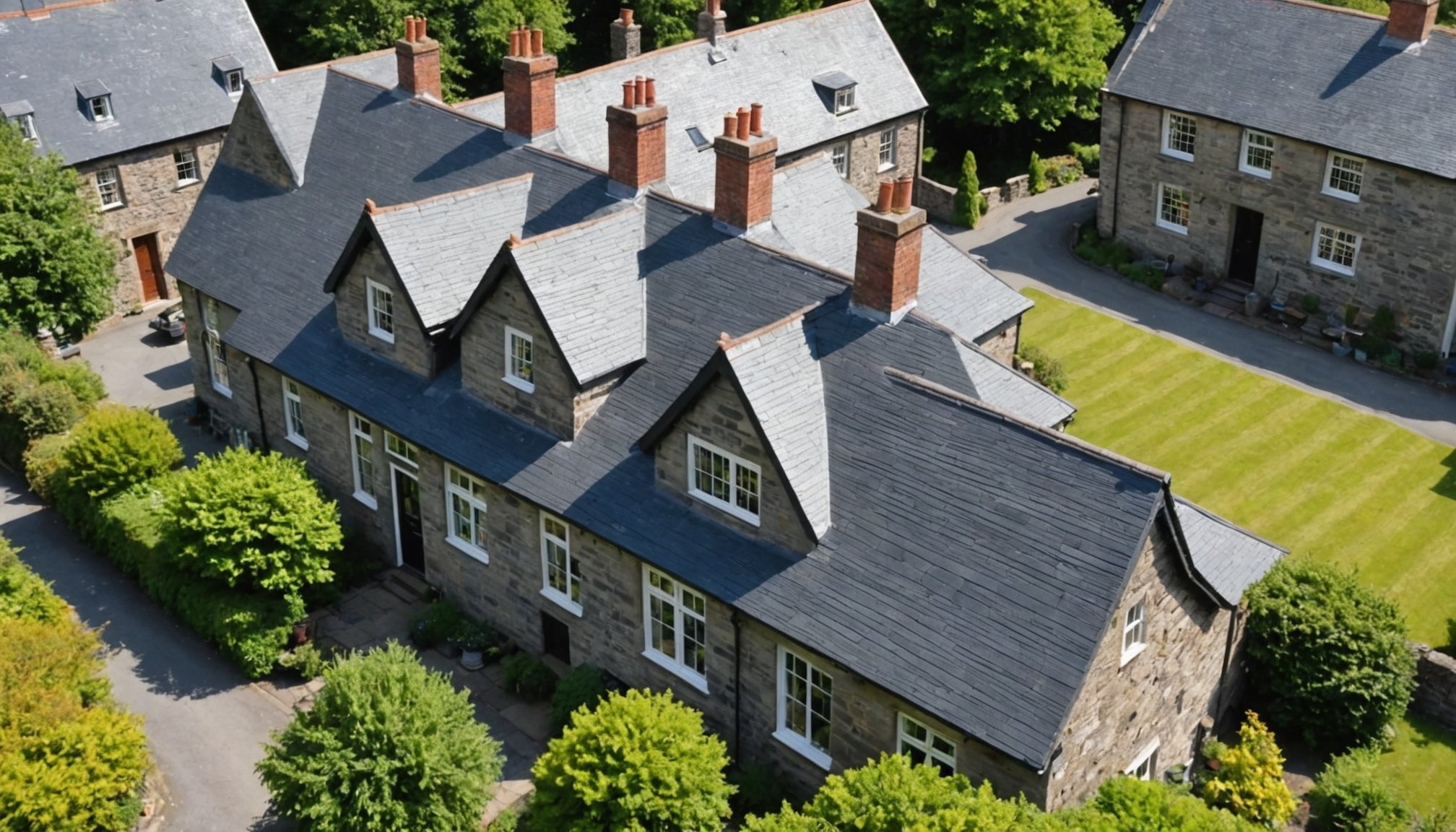Overview of Slate Roofs
Slate roofs offer a unique blend of characteristics that make them a favored choice among many homeowners. Slate, a naturally occurring material, is renowned for its durability and longevity, often outlasting other common roofing materials by decades. Due to its non-combustible and weather-resistant properties, slate provides exceptional protection against harsh weather conditions.
Sustainability is another strong suit of slate roofs. Since slate is a natural product, its production requires less energy compared to synthetic roofing materials. This reduces the environmental footprint, positioning slate as an eco-friendly option. Moreover, slate’s longevity means fewer replacements and less waste, contributing positively to green building practices.
A lire en complément : Surrey's top floor cleaning services: shine restoration & surface care
The aesthetic appeal of slate roofs is undeniable. Available in a variety of colors and textures, slate can enhance the visual appeal of picturesque settings. Its natural beauty adds value and charm to homes, making it a popular choice for those who seek both function and form.
For homeowners interested in both sustainability and aesthetics, slate offers an exceptional choice. The combination of its robust characteristics and minimal environmental impact makes slate a wise, long-term roofing option. Its lasting beauty ensures that homes with slate roofs remain charming for generations.
Lire également : The Ultimate Guide to Kid-Safe Paints for Bedrooms in the UK: Choosing the Best Options for Your Child”s Space
Importance of Regular Maintenance
Regular roof maintenance is crucial to avoid costly repairs and ensure longevity. Neglecting it, especially for a slate roof, can lead to severe damage. Over time, minor issues like loose or cracked slates can result in water ingress, causing structural problems.
Preventive care involves routine inspections, ideally twice a year, in spring and autumn. These checks help identify potential issues early, such as deteriorated flashing or clogged gutters, which are critical to the roof’s integrity. Spotting these issues early can prevent larger, more expensive repairs in the future.
Seasonal changes significantly influence maintenance needs. Winter, for instance, can be harsh on roofs, with snow and ice potentially dislodging slates or causing leaks. Spring is an excellent time to assess any damage that winter might have caused and to prepare your roof for summer heat. Conversely, in autumn, removing leaves and debris from gutters helps maintain effective drainage during the rainy season and prevents water accumulation that could seep into the roof.
By adhering to a maintenance schedule aligned with seasonal changes, you can ensure your roof’s resilience and long-term performance. This proactive approach not only safeguards your property’s value but also provides peace of mind.
Cleaning Techniques for Slate Roofs
Caring for a slate roof requires specialised cleaning methods to maintain its beauty and longevity. Essential to slate roof care is the use of tools that gently remove debris without causing damage. Avoid high-pressure washers, as they can crack and shorten the life of the slates.
Instead, opt for soft-bristle brushes or low-pressure washers specifically designed for roof cleaning. They dislodge moss, algae, and dirt effectively while being gentle on the material. A non-abrasive cleaning solution can also be used to treat any stubborn stains without compromising the roof’s integrity.
The local environment significantly influences the frequency of cleaning. In areas with high rainfall, trees, or humid conditions, moss and algae tend to accumulate faster. A bi-annual cleaning schedule is often ideal in such environments. Conversely, for regions with less likelihood of moss growth, an annual check-up can suffice.
To keep your slate roof in optimum condition, regularly inspect it for signs of wear or damage, particularly after heavy storms. This preventive slate roof care approach helps address issues early and extend the lifespan of your roof, safeguarding your home’s investment. Through diligent cleaning and maintenance, your slate roof can remain a stunning feature for decades to come.
Inspecting for Damage
Understanding the condition of your slate roof is crucial for its longevity. Key indicators of potential damage might include missing or cracked tiles, and areas where the slate appears warped or discoloured. Regular roof inspection of slate roof can help in early identification of such issues.
For a DIY inspection, start by checking the ground around your home for fallen slate fragments. Next, observe your roof from a safe distance. Look for any visible signs of wear: damaged tiles, inconsistent colouring, or any atypical surface texture. However, a thorough damage assessment requires careful inspection up close, which can occasionally be dangerous without the proper tools and expertise.
If you suspect significant damage, it may be wise to call a professional. Professional inspectors have the skills to accurately assess the slate tile condition and ensure safe inspection practices. They can conduct a detailed damage assessment, identifying issues that might not be apparent at first glance.
Deciding when to call a professional often depends on the extent of the visible damage and your comfort level with performing the inspection. Sometimes, expert intervention is necessary to protect the structural integrity of your roof.
Repairing Slate Roofs
Slate roofs are renowned for their durability, yet they eventually require attention. Common issues necessitating roof repairs include cracked or slipping tiles, water damage, and weather-induced wear. Addressing these early can prevent more extensive damage and maintain the roof’s longevity.
For minor repairs such as small cracks or dislodged tiles, slate roof restoration involves methodical steps. It’s vital to first assess the overall condition of the roof to determine the repair scope. For small instances, replace the affected tile replacement after meticulously removing any debris or loose slate around it. Utilizing compatible materials is crucial in maintaining the roof’s structural integrity and appearance.
Using local materials for repairs is particularly critical. This ensures that the replacement tiles or slates will match the existing roof in both appearance and quality. Accessing local materials allows for consistency in tile composition and color, which is essential for the longevity and aesthetic of the slate roof.
When dealing with more intricate issues such as significant water damage or widespread tile displacement, it’s advisable to consult a professional. Their expertise ensures a precise, thorough repair process, ultimately preserving the property’s value and protection.
Investing time and care into slate roof maintenance ensures its historic charm and functionality for years to come.
Adapting Maintenance to Welsh Climate
The Welsh climate presents unique challenges for maintaining roofs, primarily due to its persistent rain and high humidity. These conditions can lead to increased wear and tear, making it imperative to adapt maintenance practices accordingly. One effective approach is to utilise local roofing techniques that are specifically designed to withstand the weather impacts typical of the region.
Welsh builders often rely on techniques that have been passed down through generations, such as using slate, which is both abundant and durable against weather stressors. This material is not only regionally sourced but also mitigates issues like moss growth and water retention. By opting for materials and methods that are locally sourced and tested, property owners can ensure a longer lifespan and better resilience for their structures.
Adapting maintenance to align with the Welish climate’s demands means regularly inspecting roofs for leaks, moisture buildup, and other signs of damage. Additionally, employing weather-resistant sealants and finishes can offer further protection against the elements. It’s also beneficial to adjust maintenance schedules to account for seasons with higher precipitation, ensuring proactive management of potential issues. By embracing local roofing techniques and understanding the nuances of the Welsh environment, homeowners can protect their properties effectively amidst the challenging climatic conditions.
Enhancing Aesthetic Value
In picturesque villages, maintaining visual appeal is crucial for preserving the area’s unique charm. The aesthetic roofing plays a significant role in this, seamlessly integrating with the traditional architecture to maintain the overall harmony of the locale.
Village charm is often derived from its architecture, which tells a story of its history and cultural heritage. Enhancing these features through thoughtfully designed roofing can highlight the village’s unique characteristics. This involves not only choosing the right materials and colours but also ensuring the shape and style of the roof align with traditional design elements.
When integrating roof design with the existing village architecture, attention to detail is key. Consider the textures and shapes commonly found in local buildings. This might involve selecting tiles that reflect traditional craftsmanship or using colours that complement the natural landscape.
Artistic elements can further enrich the visual appeal of a village. This might involve creative roof designs that enhance the scenic beauty and provide a sense of uniformity without sacrificing individuality. Community efforts often focus on incorporating decorative features, such as ornate gables or period-appropriate finials, which can add extra character to the village’s skyline. By embracing these practices, villages can boost their aesthetic value while staying true to their roots.











